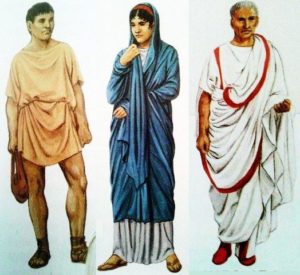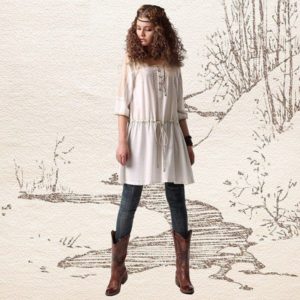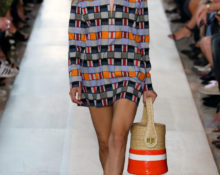 The first tunic is a bag-like garment with slits for the head and arms. Centuries-long transformation has turned it into the most popular element of the modern wardrobe. This type of clothing has one of the longest and most intense histories of transformations.
The first tunic is a bag-like garment with slits for the head and arms. Centuries-long transformation has turned it into the most popular element of the modern wardrobe. This type of clothing has one of the longest and most intense histories of transformations.
History of origin
The beginning can be considered the period before our erawhen the tribes Africa wore loose clothes made from pieces of fabric. The ancient Persians also liked such vestments (it can be called “progenitor”).
Having made their own changes, they wore this robe in the form of a long, spacious dress with sleeves and a wide belt. Moreover, it was intended to be worn exclusively by men and only among warriors.
 Similar clothing was also common in Ancient Greece – it was perfect for hot climates and scorching sun. Among the Hellenes, who did not suffer from excessive modesty, this loose, short outfit was called a tunic.The Greeks preferred to wear something that did not require sewing: a large rectangular piece of fabric was wrapped around the body and fastened at the shoulder, with a belt tied on top.
Similar clothing was also common in Ancient Greece – it was perfect for hot climates and scorching sun. Among the Hellenes, who did not suffer from excessive modesty, this loose, short outfit was called a tunic.The Greeks preferred to wear something that did not require sewing: a large rectangular piece of fabric was wrapped around the body and fastened at the shoulder, with a belt tied on top.
Culture Ancient Rome adopted quite a lot from the Greek, clothing was no exception. The general appearance underwent some changes, and the chiton became a tunic. It was made of two panels, was sleeveless, only with armholes for the head and arms.
The outfit was initially considered exclusively for men, but, as often happens, over time women began to wear it. For them, however, this vestment belonged to the underwear - when leaving the house they had to put on a long cape over it.
REFERENCE! The tunic also performed social functions: depending on its color, cut and decorative elements, one could determine a person’s position in society.
After the historical decline Ancient Rome similar clothing appeared in the wardrobe of the Byzantines, and then in Eastern culture. It was among the Arab peoples that it became widespread and varied: it was richly decorated with precious stones, embroidery and was especially popular among the upper strata of the population.
In Europe, the tunic appeared during the heyday of the Empire style - in the middle of the 18th century. But the experiments of individual fashionistas, so bold for that time, did not find understanding among society, and the outfit did not appear in the wardrobe of Europeans until the second half of the 20th century. The return to the West began thanks to the hippie movement - they paid attention to the ethnic styles of eastern peoples.

And he completely strengthened his position Yves Saint Laurent was the first to present a collection of tunics to the world. Now it is difficult to say about any exact criteria for this wardrobe element - the variety of models is so wide.They are united only by a one-piece cut (both back and front), as well as the absence of a collar. However, one thing can be said absolutely definitely: the popularity of this outfit at the present time is extremely high.
Relevance of tunics
After such a triumphant appearance in modern society, tunics have firmly established themselves in the wardrobe of almost all women. And every season this garment is presented on the catwalk of at least one fashion house.
And it’s quite simple to explain, highlighting the undoubted advantage of this outfit over others, because tunic:
- is a universal basis on which you can create a harmonious image;
- matches almost all styles and situations (be it work, a romantic date, a walk or relaxing on the beach);
- goes well with many wardrobe elements, but can also be an independent outfit;
- suitable for any woman, regardless of their build and height;
- helps visually correct the figure and hide any flaws;
- provides comfort, does not create obstacles when moving, convenient;
- applies to both summer and demi-season clothing.
ATTENTION! To choose the right model correctly, of course, you should understand the presented styles.
Types of tunics

To choose the ideal one, it is worth deciding what aesthetic and functional requirements it must meet.
So, models differ in the following parameters:
- Seasonality. Summer lightweights are great for warm days in a hot city or on the beach. Demi-season ones are usually made of some kind of dense warm material. There are products designed for cool autumn, spring, and also completely insulated ones - designed for cold winter.
- Style. In sportswear - suitable for those who love an active life. Ethnic images are created with the help of folk style outfits. Romantic models will harmoniously fit into a delicate feminine look. Classic - universal in various situations.
- Style. The choice depends on the situation for which the garment is intended and is very wide: asymmetrical, beach tunic dress, transformable and a huge number of others.
- Length. It can be: long, elongated, short.
- Material. When choosing, you should pay attention to the composition and texture of the fabric.
Despite the huge selection and diversity, there are still models that enjoy special attention among women (photo).
Beach tunic
 A beach tunic is an invariable part of the wardrobe of most representatives of the fair sex on vacation. The number of options for this product is huge, but when purchasing it is worth remembering that the model must:
A beach tunic is an invariable part of the wardrobe of most representatives of the fair sex on vacation. The number of options for this product is huge, but when purchasing it is worth remembering that the model must:
- be comfortable;
- protect from heat, sun and other harmful factors;
- emphasize all the advantages of the figure, hide flaws, if any.
IMPORTANT! The tunic should be combined with the swimsuit and the overall look.
Versions made from light flowing materials, medium length, with a loose fit and V-neck are universal.
Casual
Women's casual tunic is the most common and comes in many options. As a rule, they are combined with various types of trousers, leggings or jeans. But there are styles that are somewhat different from the usual ones; they are also used to create an everyday look.

For example, these are tunics:
- Dress. It can be a separate independent element of clothing and can only be supplemented with accessories.
- Blouse. An excellent option for a business or office look; simply complement it with any classic trousers or a formal skirt.
- Shirt. In combination with trousers, it is suitable for a casual style.
Classical
Classic or "Greek" style Recently it has been gaining noticeable popularity. As a rule, these tunics are made of light, airy fabric that forms many folds.
 Thanks to their loose cut, they suit almost everyone: for overweight women they literally “drape” imperfections, and for thin women they add the necessary volume. Otherwise, the appearance of this model is varied: the length of the sleeves and the height of the waistline vary; may or may not have a belt, V-neck or open shoulders.
Thanks to their loose cut, they suit almost everyone: for overweight women they literally “drape” imperfections, and for thin women they add the necessary volume. Otherwise, the appearance of this model is varied: the length of the sleeves and the height of the waistline vary; may or may not have a belt, V-neck or open shoulders.
In ethnic style
Such options are characterized, as a rule, by colorful designs, bright ornaments and unusual cuts, and the general appearance combines some features of national costumes
REFERENCE! Ethnic style, in its modern presentation, appeared in the second half of the 20th century in the “hippie” subculture.

Tunics can be presented in the following directions:
- Country. Suede and leather products with an abundance of fringe are typical.
- Indian. Bright colors, often with an asymmetrical cut and slits on the sides.
- African. With large prints, animalistic patterns in brown tones.
- Asiatic. Made from smooth fabrics with floral patterns and simple cuts.
- Arab. Loose fit, maximum coverage of the body.
What to combine with a tunic
Of course, any look cannot be completed without a selection of shoes and accessories. Here everything completely depends on the idea in mind. For example, pumps or stiletto heels are suitable for an evening outfit. For a romantic look, you should take a closer look at ballet flats, and for everyday wear, you can choose sneakers and ankle boots.
ATTENTION! For a classic “Greek” tunic, the choice of “antique” shoes will be almost unmistakable.

Accessories - also an important point, it’s worth choosing the right ones, for example:
- belt;
- fabric scarf;
- costume jewelry;
- headdress.
This is how just one wardrobe element can become the basis for creating a huge number of looks in a variety of styles.


 0
0





